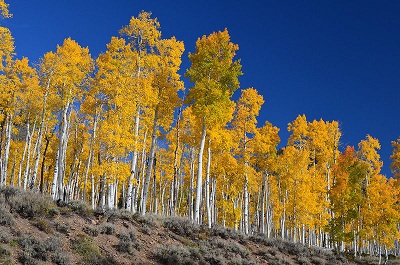The world’s largest, and possibly oldest living thing is wasting away. And guess what? – it’s mainly the fault of humans and their need to interfere. By James Teo.
The Pando aspens are part of one of the US National Forest Parks’ key species. Courtesy Zapell-PD
Utah, US. 19 October 2018. The Trembling Aspen, or populus tremuloides, or the Pando as it is sometimes called is a huge, 7,000 tonne organism spread over more than 100 acres of forest in Utah. Although it looks like a small forest of individual trees, tests have established that it is a single massive, cloned organism. It uses a single 80,000 year old root system to send up suckers that create new trees. And some researchers say it could be part of a 1,000,000,000 year old original plant. It is special. But sadly, it is in danger.
Terrance Holsclaw, Silviculturist with the Fishlake National Forest where the pando grows, says that there are an estimated 5,000 trees in the group, but the problem is that regeneration – unlike in previous centuries – is not happening to ensure ongoing growth.
Silviculturist Terrance Holsclaw says the the die-back could be caused by multiple culprits. Courtesy Forest Parks.
“From a Forest Service perspective, that’s a real problem,” says Holsclaw. “Typically, aspen stands regenerate themselves, but here there is in general no regeneration happening for some reason,” he says.
Paul Rogers, adjunct associate professor at Utah State University and author of a recent study on the pando, puts it more succinctly. Today, he says, “… there are few young or middle-aged trees at all. It’s like the forest is made up entirely of elderly senior citizens.” Which means that the forest will soon start to shrink, as the old folks die.
The State Forest team looking after the grove issue explain the root system is either not sending up new, strong enough suckers to turn into trees, or that they are not being allowed to grow into tall, quivering adults.
“We have a theory that it’s herbivores that are browsing off the young shoots,’ says Forest Ranger Kurt Robbins. “Or it could just be the pando is old and doesn’t have the energy. Then there’s another theory that a fungus is causing the problem. Or something to do with fire. We have to find out which it is.”
The rangers have taken a first step, and fenced off about 90 acres to prevent access by deer and other shoot-nibbling animals.
Although new shoots are appearing, the grove is now mainly old growth. Courtesy Forest Parks.
“We are running scientific tests to try to get a better reading of what the effects of various things are, too,” says Holsclaw. “I think that we find the grazers play a role, but probably that’s not the only thing that is causing the decline.”
Almost all of the possible threats have, sadly, a direct or indirect link to human intervention.
Increased deer numbers are the result of hunting and killing natural predators such as wolves, wildcats, bears and other large carnivores. As their numbers have dwindled, mule deer numbers (which look great in Instagram feeds) have expanded. Possibly decimating the delicate new aspen shoots as they graze.
As most of the area is gazetted for recreational use, animals are protected from number reduction through hunting. "The deer realised that very early on, and they find [the forest] a safe harbour,” said Rogers.
Another US National Park, Yellowstone, suffered a similar problem from exploding deer numbers that it recently reintroduced wolves into the area to help control over-grazing and de-vegetation. But researchers say that’s unlikely in Utah, and allowing rifle-toting hunters in to control deer number is a no-no in such a tourist-attractive area.
As for serious fires, they don’t happen any more. Visitors like nice neat forests that have the fallen debris cleaned out, and potential firebrush got rid of in a controlled burn. It’s not natural, but it looks pretty. And it helps the junipers thrive, but not the aspen. In pre-intervention years, wildfires would rip regularly through the area, killing everything – apart from the underground pando root network. That would then send up shoots into the rich newly-sterilised, and fertile ashy soil and the aspens would reappear, fresh and stronger than ever.
The Shepherd’s Crook fungus, like many other microscopic organisms, travels handily on the boots of hikers and maybe even on the wheels of RVs that roll along Highway 25 past the forest fringe, and potentially on to new struggling shoots. The solution? To stop visitors, but again, an unlikely alternative to watching the trees gradually die back.
Fenced in regeneration areas are seeing some success in helping new growth for the pando. Courtesy Forest Parks.
“The aspen is highly important in the Fishlake Forest. It’s a keystone species; they are highly diverse and they bring plant and animal life, and they are very important to our watersheds,” adds Robbins. He says that appreciating the uniqueness of the pando means they really must try to understand what the issues are behind the die-off, and to try to mitigate it.
“Our job is to help maintain the pando,” says Holsclaw, “not just for us, but for our kids and their kids too. It’s for future generations, not just for ourselves. We’ll have to wait and see if we are successful.”



